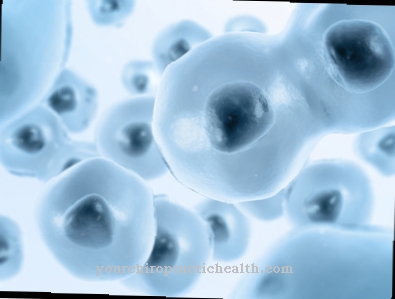With Systole is the term used in clinical parlance to describe the tension and subsequent contraction phase of the two heart chambers. During the contraction phase, the two leaflet valves, through which the blood flowed from the two antechambers into the chambers, are closed and the two pocket valves in the left and right chambers open.The blood is pumped almost simultaneously from the left ventricle into the large body circulation and from the right ventricle into the pulmonary circulation.
What is the systole?

The systole is part of the heart rhythm, which is divided into the two main phases systole (Heartbeat phase) and diastole (relaxation phase). Strictly speaking, it is the systole and diastole of the two chambers (ventricles) of the heart, because during the systole of the chambers, the two atria go through their diastolic phase and vice versa.
The ventricular systole begins with the tension phase, during which all four heart valves are closed. As the pressure builds up, the two pocket valves, the aortic valve in the left ventricle and the pulmonary valve in the right ventricle open. The contracting ventricular muscles now press the blood into the aorta, the large body artery, and into the pulmonary artery (pulmonary artery).
The duration of the systole remains relatively constant even with different physical loads and is around 300 to 400 milliseconds in adults. The time of diastole can, however, vary considerably depending on the body's oxygen requirements, so that there is a strong heart rate variability. In a healthy, normal sports person, the pulse can therefore vary between about 60 heartbeats per minute (resting pulse) and 160 to 200 (maximum frequency), with the maximum frequency decreasing depending on age.
Function & task
With its beating rhythm, the heart ensures that the blood circulation is maintained. The systoles of the right and left ventricles run simultaneously and are electrically controlled via sinus and AV nodes as well as via the bundle of His and the Purkinje fibers. The systole thus corresponds to the work rate of the heart. As soon as the pressure in the chambers built up during systole exceeds the residual diastolic pressure in the aorta and pulmonary artery, the two pocket valves, the aortic valve and the pulmonary valve, open.
With the onset of diastole, the blood pressure in the chambers drops due to the relaxing heart muscles and there is a risk of blood backflow. To prevent this from happening, the two pocket flaps close again. They open and close passively, which means that, unlike the two sail flaps, they do not have their own muscularly supported, active closing or opening mechanism.
The blood that is pumped from the left ventricle into the aorta is rich in oxygen because it has previously undergone a gas exchange between carbon dioxide and oxygen on the walls of the alveoli.
After it penetrates the body tissue via the aorta with all its branches and ramifications down to the level of the arterioles and capillaries, the reverse metabolic process takes place. Carbon dioxide is absorbed by the blood in the capillaries and oxygen diffuses through the capillary walls into the surrounding tissue.
The body can only benefit optimally from the important process of systole if all other components function accordingly. The electrical control of the heartbeat is of particular importance. In addition, the functionality of the four heart valves must be guaranteed so that the heart can build up the necessary pressure. The optimal elasticity of the arteries must also be guaranteed, as they influence the arterial blood pressure through the elasticity of their walls.
The correct course of the heart rhythm and its functionality can be determined to a certain extent by listening to the specific heart sounds with a stethoscope and with the help of an electrocardiogram (EKG).
Illnesses & ailments
The effectiveness of the systole depends primarily on the functionality of the heart valves and arteries. The functioning of the systole itself, in turn, depends on the proper supply of oxygen and nutrients to the heart muscles and on electrical impulses. Pathological disturbances in the supply of the heart muscle as well as cardiac arrhythmias due to incorrect initiation or incorrect transmission of electrical impulses lead to the most frequently diagnosed heart problems.
A common clinical picture results from sclerotically altered coronary vessels. Typical symptoms of the disease are pain or pressure in the chest, which can radiate to the lower jaw, shoulders or arms. The symptoms can be signs of an impending heart attack (myocardial infarction), which is triggered by the occlusion of a coronary artery.
Cardiac arrhythmias that are caused by incorrect generation of the electrical shock pulse or by incorrect transmission of the initiated pulse occur even more frequently. The most common cardiac arrhythmia is atrial fibrillation, which is usually not immediately life-threatening, but often means a reduction in performance. Atrial fibrillation is usually accompanied by arrhythmias or tachycardias (rapid heartbeat). In the case of chronic atrial fibrillation, the risk of secondary damage such as heart muscle enlargement and stroke increases, as clots can form in the atrium due to the disordered blood flow. These can be washed out and cause vascular occlusion in the brain.
Atrial fibrillation is usually associated with a loss of sinus rhythm, which is initiated by the sinus node in the left atrium and transmitted to the heart muscle via the AV node, the bundle of His and the Purkinje fibers. So-called ventricular fibrillation, which can lead to disordered excitation within the chambers with a frequency of up to 800 beats per minute, is less common, but also far more dangerous. Since the chambers can no longer fill and empty due to the high beat frequency, the condition is immediately life-threatening.



























